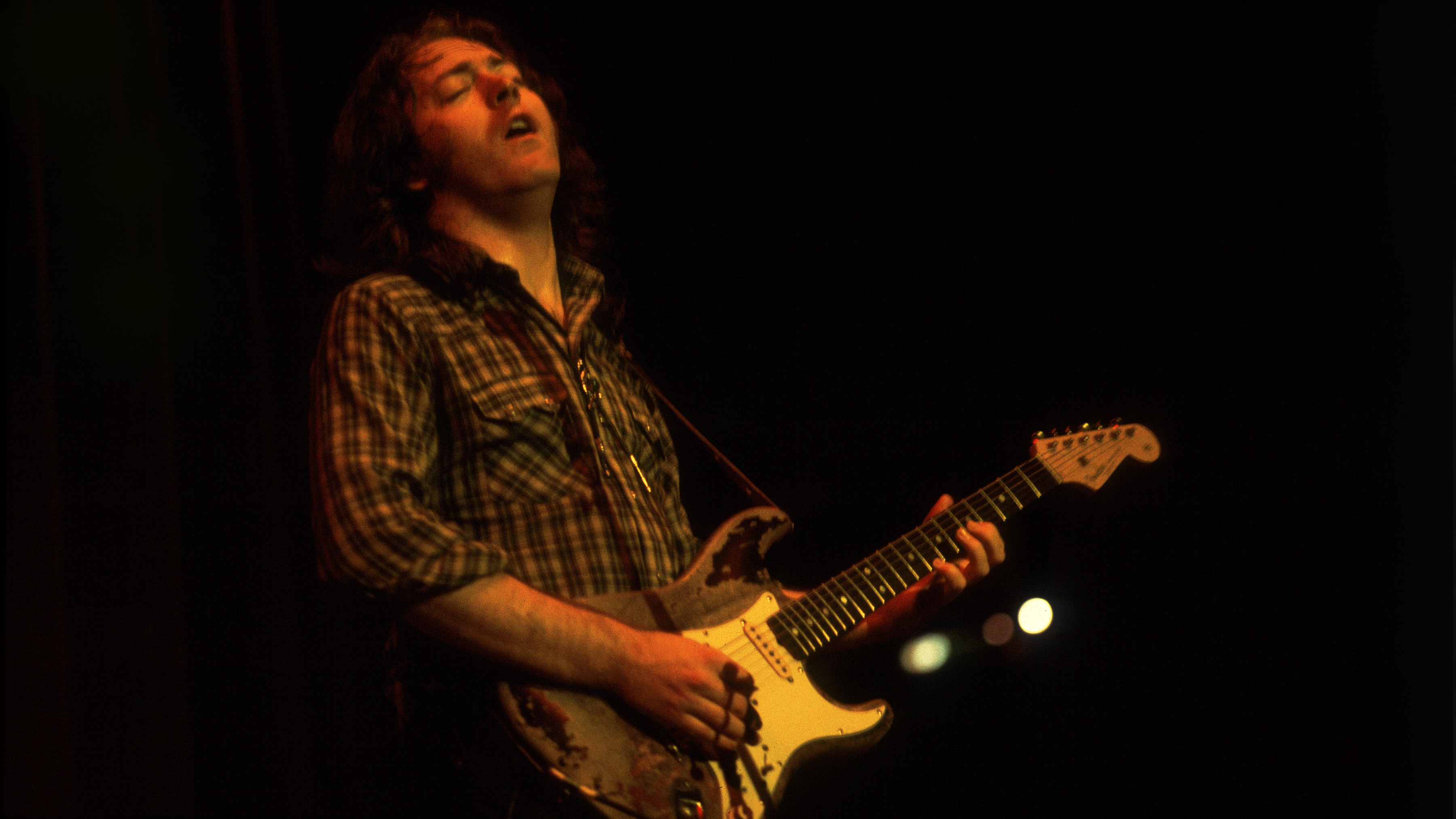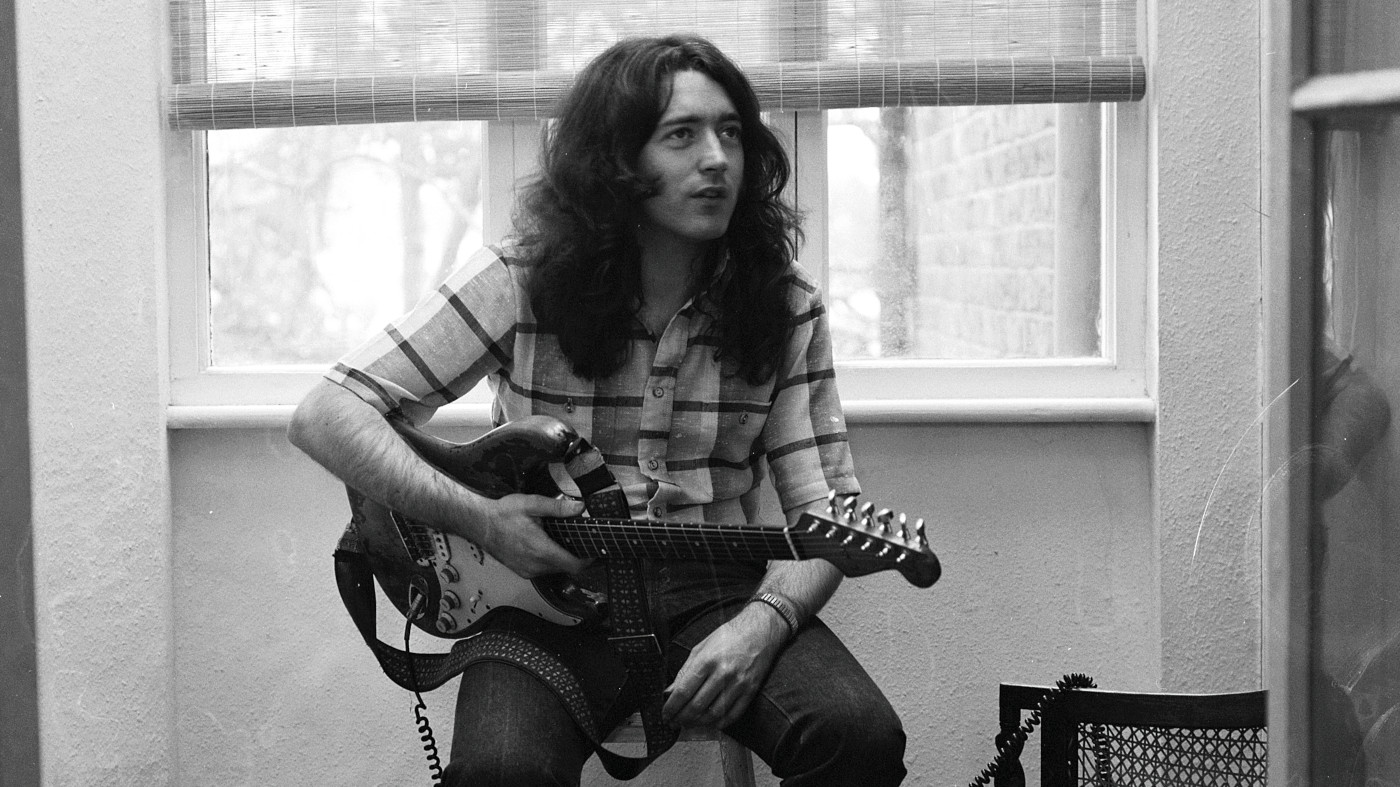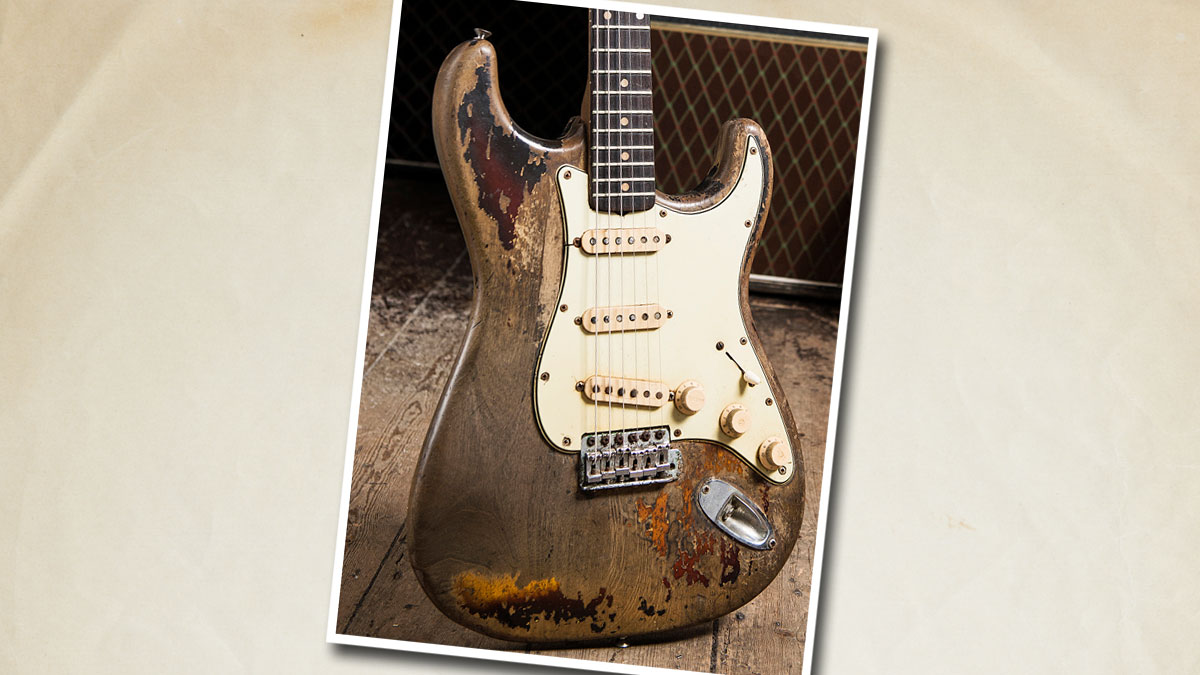5 Rory Gallagher songs guitarists need to hear
Check out these key tracks from the electric blues icon

The great Rory Gallagher, cited as an inspiration by players as diverse as Clapton, Brian May, Joe Satriani, Joe Bonamassa, Slash, Johnny Marr and The Edge, would have celebrated his birthday this week, so check out our introduction to some of his most loved works, as well as a few lesser-known gems.
Born in 1948 in the tiny Irish town of Ballyshannon, County Donegal, Rory Gallagher is, without doubt, one of the most significant musicians to have ever emerged from the Emerald Isle.
Renowned for his blistering (and very loud) live performances, he was a highly gifted interpreter of the blues who could produce electric, acoustic and slide numbers with equal levels of authenticity, flair and skill.
The 1970s were Rory's most prolific period for writing and recording and he produced 10 albums in the decade, including two live releases: Live in Europe and the Irish Tour '74.
He was also voted Melody Maker’s International Top Guitarist of the Year in 1972 - ahead of Eric Clapton, who by this time, had already been mythologised by guitar fans as “God”. The Rolling Stones even offered him a job when Mick Taylor left the band in 1975, before the role was eventually filled by Ronnie Wood.
Gallagher, however, was committed to his own music, his own direction and his own rules. Never one for caring about making hit singles, or chasing fame at the expense of his craft, he’d rock stages across the world dressed in the same checked shirt and jeans he’d probably worn down the pub the night before. This ‘working man’ image was of course completed by the legendary tool of his trade: his battered and beaten 1961 ‘number one’ Fender Stratocaster. A workhorse guitar if ever there was one, its sunburst finish had been all but stripped away by Rory’s unusually acidic sweat.
Players as diverse as Clapton, Brian May, Joe Satriani, Joe Bonamassa, Slash, Johnny Marr and The Edge have cited him as an inspiration, proving that Rory’s musical influence transcends not only genres but generations.
Get the MusicRadar Newsletter
Want all the hottest music and gear news, reviews, deals, features and more, direct to your inbox? Sign up here.
For the 21st Century player just discovering the Irish virtuoso, this short list aims to provide an introduction to some of his most loved works, as well as a few lesser known gems.
1. What’s Going On – Taste – On The Boards (1970)
After doing his time on the characterless circuit of Irish showbands for a number of years, Rory Gallagher moved towards answering his calling as a virtuosic blues rock icon when he formed the power trio Taste in 1966.
The band supported Cream at their 1968 farewell concerts and supported Blind Faith on their 1969 USA tour. The following year, they released their second album, On The Boards with What’s Going On setting the tone as its rocking opening track.
The double-tracked opening riff jolts between a hammer-on and pull-off lick and staccato chords. It’s the type of riff that makes the listener stop what they’re doing and pay attention, and the band - perhaps being aware of this - would often open their live sets with it.
The chord progression under the solo, which ascends from Bb to C to D power chords, provides enough of a blank canvas for Rory to employ some interesting notes in his fiery improvisational solo as well as some unorthodox phrasing, before the energetic track burns itself to a close at just 2 minutes and 46 seconds
The song was released as a single by Taste's manager and record label Polydor without Gallagher's knowledge and it went straight to No.1 in Germany and entered the UK Top 10. Gallagher was not happy. He had wanted the band’s image to be built around blues rather than the more commercially viable rock sound that What’s Going On epitomised - especially when taken out of context of the record as a whole.
Gallagher was upset that the decision had been taken out of his hands and the other two members of the trio, John Wilson and Charlie McCracken, backed him up. But nevertheless Gallagher quit Polydor later that year and began working on his solo project.
Whilst the arguments surrounding What’s Going On may have marked the beginning of the end for Taste, it was still very much just the start for Rory.
2. Cradle Rock - Tattoo (1973)
1973’s Tattoo boasts some of Rory Gallagher’s most enduring material. Tracks like A Million Miles Away and Tattoo’d Lady are up there with the best of them, but the album’s second track, Cradle Rock is a must-hear, not least because Rory and the band played it with such ferocious energy that - if harnessed - could surely power a small village for about a week.
Cradle Rock is one of Rory’s most aggressively paced pieces of music and its rocking R&B riff rips along with barely a let-up for over 6 minutes - even on the studio version. A general maxim of rock composition tends to be: the faster the tempo, the shorter the song. But in this case, Rory must have missed the memo - probably because he was enjoying himself way too much.
Cradle Rock is also where you’ll find some of Rory’s most electrifying slide guitar work. Although Rory would come to favour a Fender Telecaster for electric slide playing, the footage from the Irish Tour ‘74 film shows him blazing through the song on his trusty ‘61 Strat, eyes closed and sliding about the neck with total pitch-perfect accuracy. It’s a remarkable display of technical skill and creative flair.
Born at The Rock Hospital in Ballyshannon, the irony was perhaps not lost on Rory that he had rocked right from birth, and sadly he also rocked right up until he dropped. After being forced to cut his tour short in January 1995, he was hospitalised in London with liver failure. Following complications after what had seemed to be a successful transplant operation, he died in June 1995.

Interview: Joe Bonamassa on playing Rory Gallagher's 1961 Stratocaster
The legacy, however, lives on and 21st Century blues maestro, Joe Bonamassa, brought Cradle Rock back to life on his debut album A New Day Yesterday. Donal Gallagher even allowed Joe to borrow Rory’s Strat for a performance of the song at London's Hammersmith Apollo back in 2011.
3. Edged in Blue - Calling Card (1976)

Donal Gallagher: “Playing with Muddy Waters was Rory’s badge of honour”
While much of the most celebrated material in Rory Gallagher’s catalogue is muscular blues-rock - the kind that would make a brilliant soundtrack to a late night bar brawl with chair legs and pool cues flying everywhere - Edged In Blue is quite the opposite. Melodic, introspective and tinged with sadness, the song was released in 1976 on Rory’s sixth studio album, Calling Card.
The instrumental introduction, which lasts well over a minute, features some of Rory’s most melancholic lead playing, as he opts for a clean tone, languid bends and tones down the natural energy in his vibrato. The track is then propelled into action by a marching snare beat and we’re treated to some dirtier, more trebly lead tones in both the main and outro solos.

Classic interview: Rory Gallagher talks creativity, Fenders and blues legacy
The song follows more of a pop chord progression than a blues one and, with its catchy chorus and stunning lead work, Edged In Blue had all the components of a potential hit single. Even Chris Wright, then the boss at Chrysalis Records, advised Rory that it could be a contender for a number one hit in the USA, but Rory had long since shunned the singles market, as well as the concept of mainstream fads, fashions and fame in general.
A few years earlier, in 1972, he’d told Rolling Stone, “It seems a waste to me to work and work for years, really gettin’ your music together; then to make it big, as some people do, and just turn into some sort of personality. You play less, you perform less, you circulate less. It becomes something completely different.”
And so, Edged In Blue remained an album-only release, but nonetheless a gem of both the album and Rory Gallagher’s catalogue as a whole.
4. Barley & Grape Rag - Calling Card (1976)

Much as Rory did in his live sets, we’re now going to take an acoustic interlude, with Barley & Grape Rag - again from 1976’s Calling Card.
As its title suggests, the song has a toe-tapping ragtime feel and Rory played it on his 1932 National Triolian Resonator - a guitar that he picked up from a travelling salesman while on tour in the US in 1973.
A rustic drinking song of sorts, the original studio version kicks off with a playful count-in strummed partly on the brightest-sounding section of the guitar’s strings - between the bridge and tailpiece - and partly thumped on the guitar’s body. A rapid descending lick then leads into the famous opening line, 'Well I don’t care if I get arrested', and the song is powered by a jauntily picked rhythm part. For this, Rory used a pick rather than his fingers, accentuating the guitar’s naturally bright tone.
Donal Gallagher, Rory’s brother has since given an insight to the way the track was recorded, writing: “This acoustic track was recorded in the dining room of the studio, with the band members gathered round Rory as he played. As you imagine the scene and listen to the track, you can hear the intimacy and warmth they felt for each other. It came to the attention of the Dubliners who, much to Rory’s delight, recorded a version of it for their 1992 album ’30 Years A’ Greying’.”
Live, ‘Barley & Grape Rag’ proved as much of a crowd pleaser as the full-band, heavy rocking numbers, and you can hear the crowd clapping, stomping and whooping along in a version recorded live from Sheffield City Hall on the Check Shirt Wizard: Live in ‘77 album.
5. Bad Penny – Top Priority (1979)
Top Priority was Rory’s eighth solo studio album, and the last one he managed to squeeze into a particularly prolific decade. As with Photo Finish, which he’d released the previous year, Top Priority saw a move towards hard rock and a return to the power trio format with Gerry McAvoy on bass and Ted McKenna on drums.
Bad Penny, which opened the LP’s second side, is perhaps the album’s most well-known and well-loved track.
The song’s gutsy, slightly resentful lyrical themes are backed by big, chunky chords, but the star of the song is its melodic lead refrain. Doubled-up – giving it a Thin Lizzy-esque feel – this catchy line repeats between verses, almost like a chorus all of its own. The lick echoes the vocal melody, but Rory embellishes it with increasing variations each time it’s played. Later, it forms the framework for the song’s squealing solo. Being the gifted improviser that he was, Rory would usually expand the solo section for the stage, and a particularly electrifying version can be heard on the 1980 live album, Stage Struck.
I’m happier in a three-piece band
Rory Gallagher
The powerful sound of Bad Penny and Top Priority as a whole is reminiscent of the early days of Taste, but the production, naturally, has more of a modern feel. Reflecting on his return to the three-piece format, he told a Record Review interviewer in April 1980: “There’s something about a three-piece, you’re really back to the essentials, it’s very rhythmic and aggressive, and I like that. With keyboards you’ve got extra texture and all that, but it cuts down the free-form style. I’m happier in a three-piece band.”
Rory Gallagher's gear: the key guitars, amps and effects
Ellie started dabbling with guitars around the age of seven, then started writing about them roughly two decades later. She has a particular fascination with alternate tunings, is forever hunting for the perfect slide for the smaller-handed guitarist, and derives a sadistic pleasure from bothering her drummer mates with a preference for “f**king wonky” time signatures.
As well as freelancing for MusicRadar, Total Guitar and GuitarWorld.com, she’s an events marketing pro and one of the Directors of a community-owned venue in Bath, UK.
“Every note counts and fits perfectly”: Kirk Hammett names his best Metallica solo – and no, it’s not One or Master Of Puppets
“I can write anything... Just tell me what you want. You want death metal in C? Okay, here it is. A little country and western? Reggae, blues, whatever”: Yngwie Malmsteen on classical epiphanies, modern art and why he embraces the cliff edge










